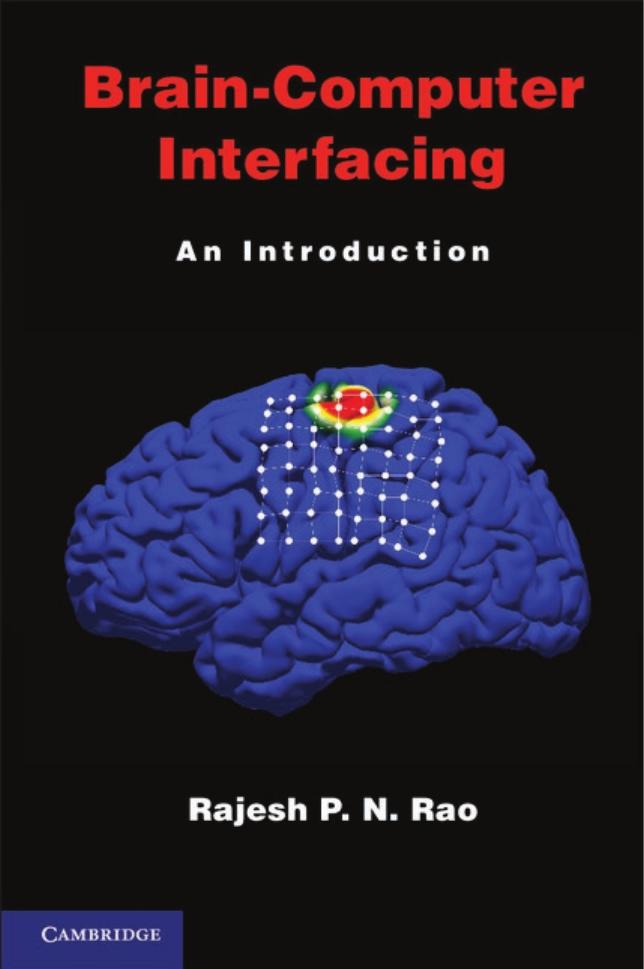Brain Computer Interfacing An Introduction 1st edition by Rajesh Rao ISBN 0521769419 9780521769419
$70.00 Original price was: $70.00.$35.00Current price is: $35.00.
Instant download Brain Computer Interfacing An Introduction after payment
Brain Computer Interfacing An Introduction 1st edition by Rajesh Rao – Ebook PDF Instant Download/Delivery: 0521769419 , 9780521769419
Full download Brain Computer Interfacing An Introduction 1st edition after payment

Product details:
ISBN 10: 0521769419
ISBN 13: 9780521769419
Author: Rajesh Rao
The idea of interfacing minds with machines has long captured the human imagination. Recent advances in neuroscience and engineering are making this a reality, opening the door to restoration and augmentation of human physical and mental capabilities. Medical applications such as cochlear implants for the deaf and neurally controlled prosthetic limbs for the paralyzed are becoming almost commonplace. Brain-computer interfaces (BCIs) are also increasingly being used in security, lie detection, alertness monitoring, telepresence, gaming, education, art, and human augmentation. This introduction to the field is designed as a textbook for upper-level undergraduate and first-year graduate courses in neural engineering or brain-computer interfacing for students from a wide range of disciplines. It can also be used for self-study and as a reference by neuroscientists, computer scientists, engineers, and medical practitioners. Key features include questions and exercises in each chapter and a supporting website.
Brain Computer Interfacing An Introduction 1st Table of contents:
1. Introduction
Part I Background
2. Basic Neuroscience
2.1 Neurons
2.2 Action Potentials or Spikes
2.3 Dendrites and Axons
2.4 Synapses
2.5 Spike Generation
2.6 Adapting the Connections: Synaptic Plasticity
2.6.1 LTP
2.6.2 LTD
2.6.3 STDP
2.6.4 Short-Term Facilitation and Depression
2.7 Brain Organization, Anatomy, and Function
2.8 Summary
2.9 Questions and Exercises
3. Recording and Stimulating the Brain
3.1 Recording Signals from the Brain
3.1.1 Invasive Techniques
3.1.2 Noninvasive Techniques
3.2 Stimulating the Brain
3.2.1 Invasive Techniques
3.2.2 Noninvasive Techniques
3.3 Simultaneous Recording and Stimulation
3.3.1 Multielectrode Arrays
3.3.2 Neurochip
3.4 Summary
3.5 Questions and Exercises
4. Signal Processing
4.1 Spike Sorting
4.2 Frequency Domain Analysis
4.2.1 Fourier Analysis
4.2.2 Discrete Fourier Transform (DFT)
4.2.3 Fast Fourier Transform (FFT)
4.2.4 Spectral Features
4.3 Wavelet Analysis
4.4 Time Domain Analysis
4.4.1 Hjorth Parameters
4.4.2 Fractal Dimension
4.4.3 Autoregressive (AR) Modeling
4.4.4 Bayesian Filtering
4.4.5 Kalman Filtering
4.4.6 Particle Filtering
4.5 Spatial Filtering
4.5.1 Bipolar, Laplacian, and Common Average Referencing
4.5.2 Principal Component Analysis (PCA)
4.5.3 Independent Component Analysis (ICA)
4.5.4 Common Spatial Patterns (CSP)
4.6 Artifact Reduction Techniques
4.6.1 Thresholding
4.6.2 Band-Stop and Notch Filtering
4.6.3 Linear Modeling
4.6.4 Principal Component Analysis (PCA)
4.6.5 Independent Component Analysis (ICA)
4.7 Summary
4.8 Questions and Exercises
5. Machine Learning
5.1 Classification Techniques
5.1.1 Binary Classification
5.1.2 Ensemble Classification Techniques
5.1.3 Multi-Class Classification
5.1.4 Evaluation of Classification Performance
5.2 Regression
5.2.1 Linear Regression
5.2.2 Neural Networks and Backpropagation
5.2.3 Radial Basis Function (RBF) Networks
5.2.4 Gaussian Processes
5.3 Summary
5.4 Questions and Exercises
Part II Putting It All Together
6. Building a BCI
6.1 Major Types of BCIs
6.2 Brain Responses Useful for Building BCIs
6.2.1 Conditioned Responses
6.2.2 Population Activity
6.2.3 Imagined Motor and Cognitive Activity
6.2.4 Stimulus-Evoked Activity
6.3 Summary
6.4 Questions and Exercises
Part III Major Types of BCIs
7. Invasive BCIs
7.1 Two Major Paradigms in Invasive Brain-Computer Interfacing
7.1.1 BCIs Based on Operant Conditioning
7.1.2 BCIs Based on Population Decoding
7.2 Invasive BCIs in Animals
7.2.1 BCIs for Prosthetic Arm and Hand Control
7.2.2 BCIs for Lower-Limb Control
7.2.3 BCIs for Cursor Control
7.2.4 Cognitive BCIs
7.3 Invasive BCIs in Humans
7.3.1 Cursor and Robotic Control Using a Multielectrode Array Implant
7.3.2 Cognitive BCIs in Humans
7.4 Long-Term Use of Invasive BCIs
7.4.1 Long-Term BCI Use and Formation of a Stable Cortical Representation
7.4.2 Long-Term Use of a Human BCI Implant
7.5 Summary
7.6 Questions and Exercises
8. Semi-Invasive BCIs
8.1 Electrocorticographic (ECoG) BCIs
8.1.1 ECoG BCIs in Animals
8.1.2 ECoG BCIs in Humans
8.2 BCIs Based on Peripheral Nerve Signals
8.2.1 Nerve-Based BCIs
8.2.2 Targeted Muscle Reinnervation (TMR)
8.3 Summary
8.4 Questions and Exercises
9. Noninvasive BCIs
9.1 Electroencephalographic (EEG) BCIs
9.1.1 Oscillatory Potentials and ERD
9.1.2 Slow Cortical Potentials
9.1.3 Movement-Related Potentials
9.1.4 Stimulus-Evoked Potentials
9.1.5 BCIs Based on Cognitive Tasks
9.1.6 Error Potentials in BCIs
9.1.7 Coadaptive BCIs
9.1.8 Hierarchical BCIs
9.2 Other Noninvasive BCIs: fMRI, MEG, and fNIR
9.2.1 Functional Magnetic Resonance Imaging-Based BCIs
9.2.2 Magnetoencephalography-Based BCIs
9.2.3 Functional Near Infrared and Optical BCIs
9.3 Summary
9.4 Questions and Exercises
10. BCIs that Stimulate
10.1 Sensory Restoration
10.1.1 Restoring Hearing: Cochlear Implants
10.1.2 Restoring Sight: Cortical and Retinal Implants
10.2 Motor Restoration
10.2.1 Deep Brain Stimulation (DBS)
10.3 Sensory Augmentation
10.4 Summary
10.5 Questions and Exercises
11. Bidirectional and Recurrent BCIs
11.1 Cursor Control with Direct Cortical Instruction via Stimulation
11.2 Active Tactile Exploration Using a BCI and Somatosensory Stimulation
11.3 Bidirectional BCI Control of a Mini-Robot
11.4 Cortical Control of Muscles via Functional Electrical Stimulation
11.5 Establishing New Connections between Brain Regions
11.6 Summary
11.7 Questions and Exercises
Part IV Applications and Ethics
12. Applications of BCIs
12.1 Medical Applications
12.1.1 Sensory Restoration
12.1.2 Motor Restoration
12.1.3 Cognitive Restoration
12.1.4 Rehabilitation
12.1.5 Restoring Communication with Menus, Cursors, and Spellers
12.1.6 Brain-Controlled Wheelchairs
12.2 Nonmedical Applications
12.2.1 Web Browsing and Navigating Virtual Worlds
12.2.2 Robotic Avatars
12.2.3 High Throughput Image Search
12.2.4 Lie Detection and Applications in Law
12.2.5 Monitoring Alertness
12.2.6 Estimating Cognitive Load
12.2.7 Education and Learning
12.2.8 Security, Identification, and Authentication
12.2.9 Physical Amplification with Exoskeletons
12.2.10 Mnemonic and Cognitive Amplification
12.2.11 Applications in Space
12.2.12 Gaming and Entertainment
12.2.13 Brain-Controlled Art
12.3 Summary
12.4 Questions and Exercises
13. Ethics of Brain-Computer Interfacing
13.1 Medical, Health, and Safety Issues
13.1.1 Balancing Risks versus Benefits
13.1.2 Informed Consent
13.2 Abuse of BCI Technology
13.3 BCI Security and Privacy
13.4 Legal Issues
13.5 Moral and Social Justice Issues
13.6 Summary
13.7 Questions and Exercises
14. Conclusion
Appendix: Mathematical Background
A.1 Basic Mathematical Notation and Units of Measurement
A.2 Vectors, Matrices, and Linear Algebra
A.2.1 Vectors
A.2.2 Matrices
A.2.3 Eigenvectors and Eigenvalues
A.2.4 Lines, Planes, and Hyperplanes
A.3 Probability Theory
A.3.1 Random Variables and Axioms of Probability
A.3.2 Joint and Conditional Probability
A.3.3 Mean, Variance, and Covariance
A.3.4 Probability Density Function
A.3.5 Uniform Distribution
A.3.6 Bernoulli Distribution
A.3.7 Binomial Distribution
A.3.8 Poisson Distribution
A.3.9 Gaussian Distribution
A.3.10 Multivariate Gaussian Distribution
References
Index
People also search for Brain Computer Interfacing An Introduction 1st :
brain computer interfacing an introduction pdf
brain computer interfacing an introduction by rajesh pn rao
brain computer interfacing an introduction by rajesh pn rao pdf
brain-computer interface examples
what is brain computer interface
how does brain computer interface work
Tags: Rajesh Rao, Brain Computer, An Introduction


